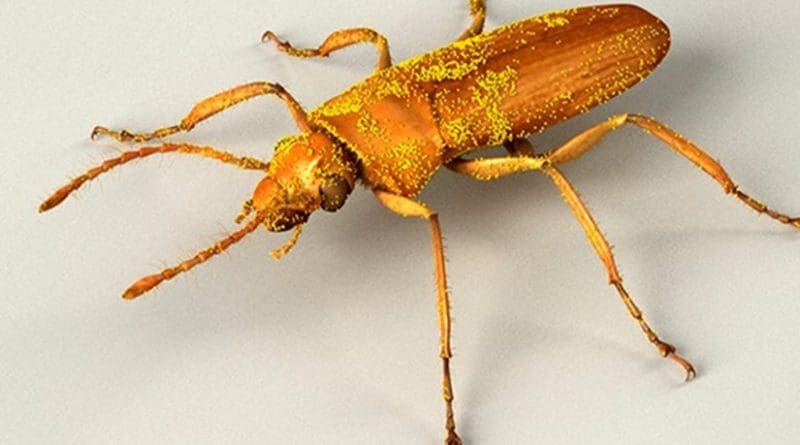New Data On Cretaceous Plants’ Pollinating Insects From 105 Million Years Ago
Darwinlyus marcosi is the name of the beetle –inspired in Charles Darwin’s passion for these insects- representing the first scientific evidence of a new pattern of pollination from insects of the middle Cretaceous, according to an article of the journal Current Biology, published by researchers of the University of Barcelona, Universitat Jaume I, and the Geological and Mining Institute of Spain, in collaboration with experts from the Smithsonian Institution and Harvard University (United States).
In the Cretaceous, about 105 million years ago, there were no ants, bees or proboscis butterflies, and most of the terrestrial ecosystems were dominated by plants without flowers (gymnosperms).
These plants were mainly conifers, and among them were the cycads, ginkgoes and the extinct benettitales, which are now generally pollinated by the wind (anemophily or wind pollination). During the mid-Cretaceous, the transition towards current terrestrial landscapes dominated by flowering plants or angiosperms took place: a new lineage of fast-growing plants which were very adaptable to all types of environments.
Darwinylus marcosi: the beetle that still pollinated gymnosperms
Dated back to more than 100 million years ago, the traces of preserved organisms in the Cretaceous amber in northern Spain are an excellent window to the most remote past. This unique specimen of beetle was found in an amber piece in Peñacerrada (Álaba), with a total of 126 pollen grains, some of which were still glued to its body. The species belongs to the family of Oedemeridae, currently known for its flower profile and for feeding exclusively from pollen and nectar from angiosperm flowers.
This found species opens a new frontier for the study of pollination in forest ecosystems that were dominated by dinosaurs.
“At first, we thought that this beetle group had a pollinating function among the first angiosperms that developed over the Cretaceous, since there is pollen and angiosperms’ leaves in the same levels of amber. However, the fact that the related pollen grains were from a gymnosperm was a big surprise for the research team,” said Professor Xavier Delcòs, from the Faculty of Earth Sciences and the Biodiversity Research Institute (IRBio) of the University of Barcelona.
The big evolutionary success of flowering plants
According to the authors, the different models of insects analyzed in the study, published in the journal Current Biology, which include all Mesozoic fossil species with buccal cavities related to pollination, point out that they all pollinated gymnosperms exclusively.
“Fossils found in amber pieces in the north of the Peninsula are a unique record in the world. In this particular case, the treated insect is the only known fossil beetle found fossilized with pollen grains from the plant it pollinated. These findings seem to prove that flowering plants could take advantage of the existing gymnosperm pollinating insects, which together with a faster growth and shorter life cycle, conferred angiosperms a crucial advantage to our days” said researcher David Peris, member of the Universitat Jaume I and PhD at the University of Barcelona with a thesis on coleopteran paleobiology.
Everything points out that the co-evolution between flowering plants and pollinating insects had not taken place yet -105 million years ago. Also, some of the gymnosperm pollinating insects –such as thysanoptera insects and oedemerid beetles, were later adapted to pollinate angiosperms. According to the experts, this is an opportunist adaptation since angiosperm flowers started offering better nutrients and became more efficient attracting insects in suggesting ways, intense odours and bright colors.
The best fossil record on pollination worldwide
There are currently thirty orders of insects, and the main angiosperm pollinating insects are bees, butterflies, flies, beetles and thrips. However, 105 years ago, pollinating bees and butterflies did not exist yet, and beetles and flies are examples of insects that feed from nectar and pollinated gymnosperm plants, according to the excellent fossil record of the amber pieces in Spain, which brought the best direct examples of pollination worldwide.
According to the results of the new research, researchers propose a model with four evolutionary patterns from gymnosperm-pollinating insects from the Cretaceous, and their following extinction or evolution up to nowadays.
In particular, these models correspond to gymnosperm pollinating insects associations that extinguished during the Cretaceous (for instance the Zhuang solitary flies found in the amber from El Soplao cave in Cantabria, Spain); groups that survived and largely continued up to now (some tisanoptera insects preserved in amber from Álaba, Spain); groups that began to pollinate angiosperms leaving gymnosperms (oedemerid beetles such as the new pollinated specimen of amber in Álava) and last, groups of pollinating insects that later began a co-evolution with angiosperms (the emblematic case of bees, or proboscis butterflies).
This new research shows the importance of amber in Spain to understand terrestrial ecosystems from the past and discover when and how some of the most relevant ecological relations now were created.

